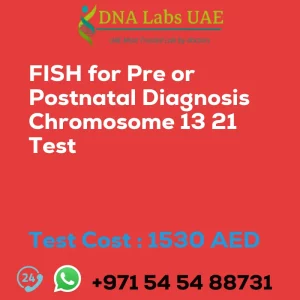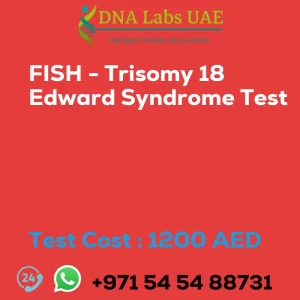FISH FOR PRE or POSTNATAL DIAGNOSIS CHROMOSOME 13 23 Test
Test Cost: AED 1400.0
Symptoms and Diagnosis
The FISH for Pre or Postnatal Diagnosis Chromosome 13 23 Test is a molecular cytogenetic technique used for the detection and analysis of specific chromosomal abnormalities. This test specifically focuses on the detection of aneuploidy for Trisomy 13 and 23. Chromosome 13 abnormalities, such as Trisomy 13 (Patau syndrome) and Deletion 13q syndrome, can lead to severe developmental abnormalities, intellectual disability, and physical abnormalities. Chromosome 23 abnormalities, which include the X and Y chromosomes, can result in conditions like Turner syndrome and Klinefelter syndrome.
Test Components
- Aneuploidy detection for Trisomy 13 23
Price
AED 1400.0
Sample Condition
Not specified
Report Delivery
10-12 days
Method
FISH (Fluorescence In Situ Hybridization)
Test Type
Gynecology
Doctor
Gynecologist
Test Department
Cytogenetics
Pre Test Information
Duly filled Prenatal Genetic Testing Consent Form (Form 18) & Chromosome & FISH analysis Requisition Form (Form 17) is mandatory.
Test Details
The FISH stands for Fluorescence In Situ Hybridization, a molecular cytogenetic technique used for the detection and analysis of specific chromosomal abnormalities. In the context of prenatal or postnatal diagnosis, FISH can be used to analyze chromosome 13 and 23 abnormalities.
Chromosome 13 abnormalities are associated with various conditions, including:
- Trisomy 13 (Patau syndrome): This is a chromosomal disorder where there is an extra copy of chromosome 13. It leads to severe developmental abnormalities and is often associated with intellectual disability, heart defects, and other physical abnormalities.
- Deletion 13q syndrome: This is a rare chromosomal disorder where a portion of chromosome 13 is missing. It can cause intellectual disability, developmental delays, and physical abnormalities.
FISH analysis can be performed on prenatal samples (such as amniotic fluid or chorionic villus samples) or postnatal samples (such as blood samples) to detect these chromosome 13 abnormalities. Specific fluorescent probes are used to target and bind to specific regions of chromosome 13, allowing for visualization and detection of any abnormalities.
Chromosome 23, also known as the sex chromosomes, includes the X and Y chromosomes. FISH analysis of chromosome 23 can be used to determine the sex of an individual or to detect abnormalities such as:
- Turner syndrome: This is a condition where females are missing one X chromosome (45,X). It can cause short stature, infertility, and other physical abnormalities.
- Klinefelter syndrome: This is a condition where males have an extra X chromosome (47,XXY). It can cause infertility, developmental delays, and other physical abnormalities.
FISH analysis can be performed on prenatal or postnatal samples to detect abnormalities in chromosome 23. Specific fluorescent probes are used to target and bind to specific regions of the X and Y chromosomes, allowing for visualization and detection of any abnormalities.
It is important to note that FISH analysis is a targeted test and can only detect specific abnormalities that the probes are designed for. For a comprehensive analysis of all chromosomes, other techniques like karyotyping or chromosomal microarray analysis may be required.
| Test Name | FISH FOR PRE or POSTNATAL DIAGNOSIS CHROMOSOME 13 23 Test |
|---|---|
| Components | Aneuploidy detection for Trisomy 13 23 |
| Price | 1400.0 AED |
| Sample Condition | |
| Report Delivery | 10-12 days |
| Method | FISH |
| Test type | Gynecology |
| Doctor | Gynecologist |
| Test Department: | Cytogenetics |
| Pre Test Information | Duly filled Prenatal Genetic Testing Consent Form (Form 18) & Chromosome & FISH analysis Requisition Form (Form 17) is mandatory. |
| Test Details |
Fish stands for Fluorescence In Situ Hybridization, which is a molecular cytogenetic technique used for the detection and analysis of specific chromosomal abnormalities. In the context of prenatal or postnatal diagnosis, FISH can be used to analyze chromosome 13 and 23 abnormalities. Chromosome 13 abnormalities are associated with various conditions, including: 1. Trisomy 13 (Patau syndrome): This is a chromosomal disorder where there is an extra copy of chromosome 13. It leads to severe developmental abnormalities and is often associated with intellectual disability, heart defects, and other physical abnormalities. 2. Deletion 13q syndrome: This is a rare chromosomal disorder where a portion of chromosome 13 is missing. It can cause intellectual disability, developmental delays, and physical abnormalities. FISH analysis can be performed on prenatal samples (such as amniotic fluid or chorionic villus samples) or postnatal samples (such as blood samples) to detect these chromosome 13 abnormalities. Specific fluorescent probes are used to target and bind to specific regions of chromosome 13, allowing for visualization and detection of any abnormalities. Chromosome 23, also known as the sex chromosomes, includes the X and Y chromosomes. FISH analysis of chromosome 23 can be used to determine the sex of an individual or to detect abnormalities such as: 1. Turner syndrome: This is a condition where females are missing one X chromosome (45,X). It can cause short stature, infertility, and other physical abnormalities. 2. Klinefelter syndrome: This is a condition where males have an extra X chromosome (47,XXY). It can cause infertility, developmental delays, and other physical abnormalities. FISH analysis can be performed on prenatal or postnatal samples to detect abnormalities in chromosome 23. Specific fluorescent probes are used to target and bind to specific regions of the X and Y chromosomes, allowing for visualization and detection of any abnormalities. It is important to note that FISH analysis is a targeted test and can only detect specific abnormalities that the probes are designed for. For a comprehensive analysis of all chromosomes, other techniques like karyotyping or chromosomal microarray analysis may be required. |







